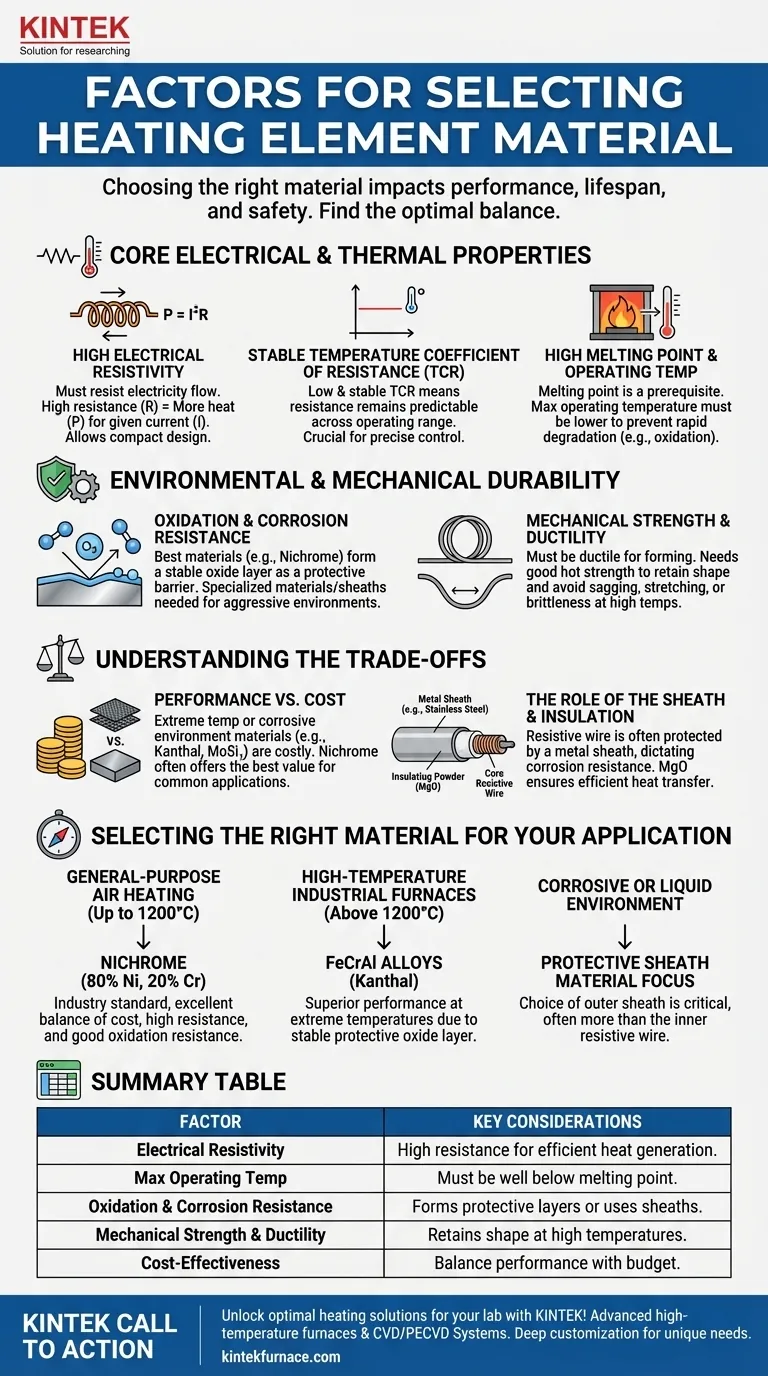Choosing the right heating element material is a critical engineering decision that directly impacts performance, lifespan, and safety. The selection process involves a careful evaluation of the material's electrical resistivity, maximum operating temperature, resistance to oxidation and corrosion, and overall cost-effectiveness for the intended application.
The goal is not to find a single "best" material, but to identify the optimal balance of properties for a specific task. An ideal element must efficiently generate heat while simultaneously withstanding the unique thermal, chemical, and mechanical stresses of its operating environment.
Core Electrical and Thermal Properties
The primary function of a heating element is to convert electrical energy into thermal energy. The material's intrinsic properties dictate how effectively and reliably it can perform this task.
High Electrical Resistivity
For a material to generate significant heat, it must resist the flow of electricity. This principle is described by Joule's Law (P = I²R). A material with high electrical resistance (R) produces more heat (P) for a given electrical current (I), allowing for efficient thermal output from a compact design.
Stable Temperature Coefficient of Resistance (TCR)
As a material heats up, its resistance changes. A material with a low and stable TCR is desirable because its resistance remains relatively predictable across its operating temperature range. This stability is crucial for designing precise and reliable temperature control systems.
High Melting Point and Operating Temperature
A high melting point is a fundamental prerequisite, as the material must remain solid well above its intended use temperature. More importantly, the maximum operating temperature is the practical limit at which the material can function without rapid degradation, such as oxidation. This operating limit is always significantly lower than the absolute melting point.
Environmental and Mechanical Durability
A heating element must not only produce heat but also survive its working conditions over thousands of hours. Its ability to resist environmental degradation is just as important as its electrical properties.
Oxidation and Corrosion Resistance
At high temperatures, most metals react with oxygen in the air. The best heating element materials, like Nichrome (Nickel-Chromium), form a thin, stable, and adherent oxide layer on their surface. This layer acts as a protective barrier, preventing further oxidation that would otherwise cause the element to degrade and fail. For applications in chemically aggressive environments, specialized materials or protective sheaths are required.
Mechanical Strength and Ductility
The material must be ductile enough to be drawn into wire and formed into coils without breaking. It must also possess good hot strength, meaning it retains its shape and does not sag, stretch, or become brittle when held at high temperatures for long periods.
Understanding the Trade-offs
Selecting a material is an exercise in balancing competing factors. No single material is perfect for every situation, and understanding the compromises is key to making an informed decision.
Performance vs. Cost
Materials capable of reaching extreme temperatures or withstanding highly corrosive environments, such as FeCrAl alloys (Kanthal) or Molybdenum Disilicide, are significantly more expensive than standard alloys. For many common applications, the proven performance and lower cost of Nichrome offer the best value.
The Role of the Sheath and Insulation
The resistive wire is often just one component of a larger assembly. In many tubular heaters, the core wire is protected by a metal sheath (e.g., stainless steel, Incoloy) and electrically isolated by an insulating powder like Magnesium Oxide (MgO). In these cases, the sheath material dictates the element's corrosion resistance, while the MgO ensures efficient heat transfer from the core to the sheath.
Selecting the Right Material for Your Application
Your final choice depends entirely on balancing performance requirements with environmental conditions and budget.
- If your primary focus is general-purpose air heating (up to 1200°C): Nichrome (80% nickel, 20% chromium) is the industry standard, offering an excellent balance of cost, high resistance, and good oxidation resistance.
- If your primary focus is high-temperature industrial furnaces (above 1200°C): FeCrAl alloys (Kanthal) provide superior performance at extreme temperatures due to their more stable protective oxide layer.
- If your primary focus is operating in a corrosive or liquid environment: The choice of the protective outer sheath material becomes the most critical factor, often more so than the inner resistive wire itself.
By methodically evaluating these electrical, thermal, and environmental factors, you can select a material that ensures reliable, efficient, and safe thermal performance for your project.
Summary Table:
| Factor | Key Considerations |
|---|---|
| Electrical Resistivity | High resistance for efficient heat generation from compact designs |
| Maximum Operating Temperature | Must be well below melting point to prevent degradation |
| Oxidation and Corrosion Resistance | Forms protective layers (e.g., Nichrome) or uses sheaths for harsh environments |
| Mechanical Strength and Ductility | Retains shape and form at high temperatures without brittleness |
| Cost-Effectiveness | Balance performance with budget; standard alloys like Nichrome for value |
Unlock optimal heating solutions for your lab with KINTEK! Leveraging exceptional R&D and in-house manufacturing, we provide advanced high-temperature furnaces like Muffle, Tube, Rotary, Vacuum & Atmosphere Furnaces, and CVD/PECVD Systems. Our deep customization capability ensures precise fit for your unique experimental needs. Contact us today to enhance performance and durability in your thermal processes!
Visual Guide

Related Products
- Silicon Carbide SiC Thermal Heating Elements for Electric Furnace
- Vacuum Heat Treat Furnace with Ceramic Fiber Liner
- Molybdenum Vacuum Heat Treat Furnace
- Small Vacuum Heat Treat and Tungsten Wire Sintering Furnace
- 2200 ℃ Graphite Vacuum Heat Treat Furnace
People Also Ask
- What parameters does the IEC standard specify for heating elements? Ensure Safety and Performance
- What is silicon carbide used for in heating applications? Discover Its High-Temperature Durability
- What types of heating elements are commonly used in drop tube furnaces? Find the Right Element for Your Temperature Needs
- What temperature ranges are recommended for SiC versus MoSi2 heating elements? Optimize Your Furnace Performance
- What are the advantages of silicon carbide heating elements in dental furnaces? Boost Zirconia Sintering Quality



















